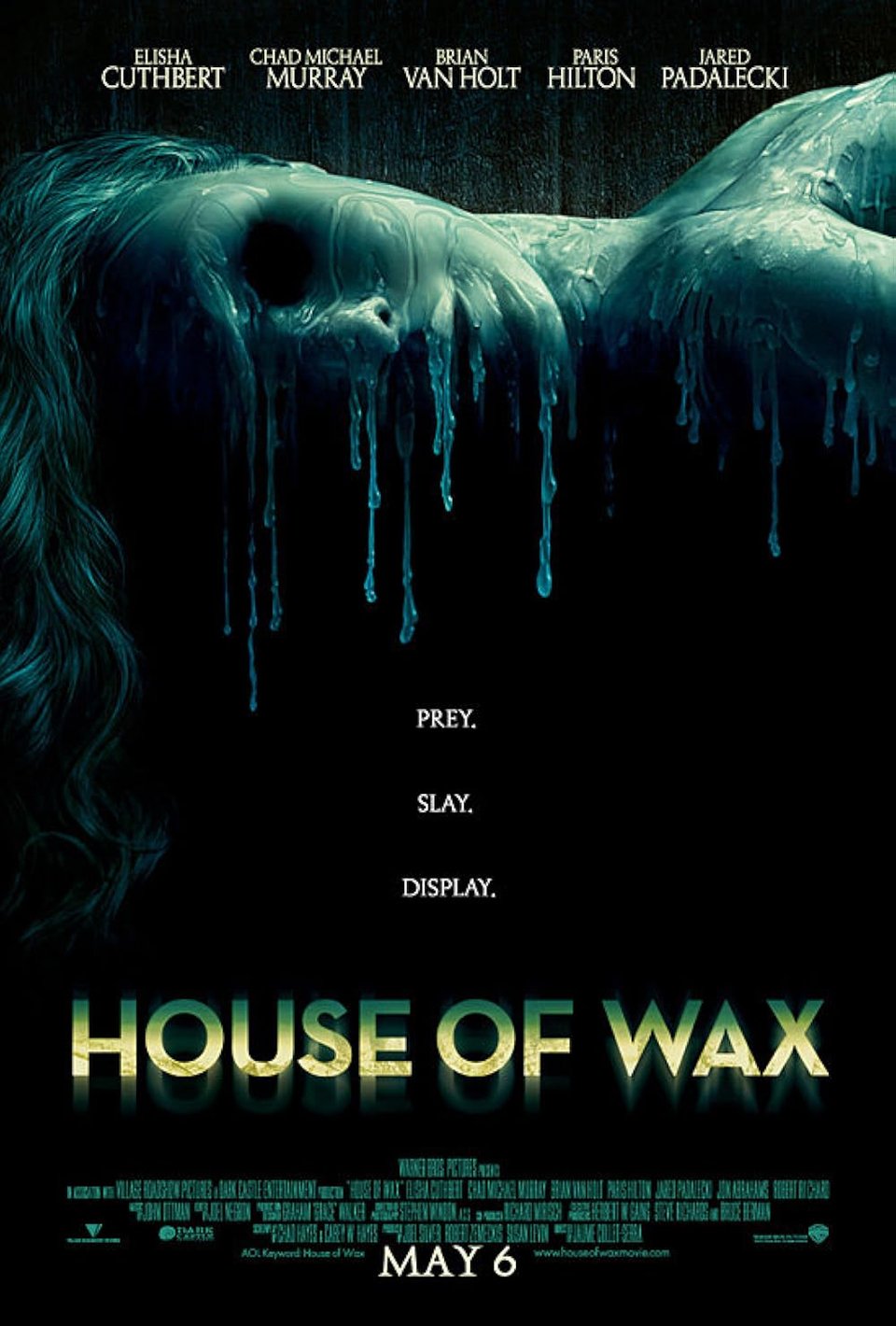Remember when we paid to "See Paris Die"?
Hey you,
Cheers for opening this email. You’re reading the first issue of She’s Got Guts, the monthly feminist horror newsletter.
I wanted to kick this series off with a horror zeitgeist moment you may have forgotten — the time we gleefully bought cinema tickets to watch Paris Hilton get ‘unalived’.
I am, of course, referring to 2005’s House of Wax, directed by Jaume Collet-Serra. It shares a name with the 1953 classic (although the plot is very different), and its cast is studded with early 00s talent, including Elisha Cuthbert and Chad Michael Murray.
HoW has some genuinely inventive, gory moments. Its climax is a delicious mix of fire, molten wax, and melting set pieces.

All things considered, you’d think this would make one helluva compelling marketing campaign. But Warner Bros. decided to take a very different direction.
They killed Paris Hilton.

Warner Bros. chose to use Paris Hilton as the primary marketing lure.
The film’s poster is a fetishistic image of Paris, her face and chest suggestively slathered in dripping white (“wax”) goo. It was launched alongside a viral marketing campaign named ‘See Paris Die’. They even made T-shirts.
Lemme jog your memory…

And it worked. The film grossed $70 million worldwide and raked in $42 million in DVD and VHS rentals. Sure, the critic reviews weren’t rad, but by then, Warner Bros. had already recouped their $40 million investment.
Paris didn’t seem to mind, either. She was delighted with her “cool” death scene and was quoted as being thrilled to have been part of the experience. She told Hollywood.com she was laughing and cheering with the audience.
Hell, she even won several awards for her feature film debut, including a Razzie for Worst Supporting Actress, a Teen Choice award, and an MTV Movie award.
It’s a shame the marketing campaign needed to capitalise on our unhealthy hatred for feminine power.
Society has a real problem with ‘girliness’.
It’s a well-documented societal struggle, typically characterised by a general disdain for anything pink, frilly, emotional, or soft. Teenage girls and their interests are a particular point of contention — anything they enjoy usually finds itself at the top of the tear-down pile for the rest of the world. John Green novels, One Direction, BTS, you name it, we hate it.
And back in 2005, teen girls couldn’t get enough of aught’s ‘it girl’, Paris Hilton.
Clad in a hot pink velour tracksuit, long blonde hair gleaming, and a bejewelled Blackberry clasped in one hand and chihuahua in the other, Paris was queen of the girly girls.
And the world loathed her for it.
To add insult to injury, Paris was born into wealth and privilege. The daughter of Hilton Hotels mogul Paris seemingly gained fame by partying, being pretty, and making a sex tape.
This brings us to the second thing we can’t seem to stand — women who own their sex appeal. Worse, women who own it and monetise it.
So, Warner Bros took all that pent-up disdain and spun it into an irresistible marketing campaign.
I mean…who wouldn’t spend a tenner on a cinema ticket to watch Paris cry, beg, run, and die painfully?
She deserves it. Doesn’t she?
At the core, this is a dangerous game of ‘punish the slut’.
Paris is a lot of things to a lot of people.
She’s the pretty girl you’ll never get to date
She’s the popular girl who makes you feel ugly
She’s the wealthy undeserving
She’s the head-turning siren
Truth is, none of us actually know Paris. All we know is what the media shows us and what Paris herself chooses to show the world (we’ve since learned the bimbo persona was just an act, but even if it wasn’t…who gives a fuck?). Those representations are things we’ve projected onto her.
And it’s dangerous to reward that hatred because we’re all someone else’s Paris Hilton.
By leaning into that public hatred, you’re telling the world it’s okay to lash out at anyone you perceive to be deserving of violent punishment. Anyone who needs to be taken down a peg. Namely, women and feminine-presenting individuals who dare to be confident, sexually liberated, or hyper-feminine.
It also signifies that age-old primal desire to destroy something beautiful or pure. We see it so often in true crime cases and countless horror films — a gorgeous girl is brutalised until she’s nothing more than a mangled mess. It’s almost pornographic in its execution. Male on-screen deaths are rarely fetishised in the same way.
Horror is (thankfully) moving away from the tired trope of punishing the ‘slut’, but I’m not confident the marketing will ever get there — public desire is still too strong.
If Warner Bros. launched a horror film ad campaign tomorrow featuring the tagline ‘See Kim Kardashian Die’, I’ve no doubt it’d be just as successful.
And that’s a worrying thought, indeed.
See ya in the next one,
Cowners